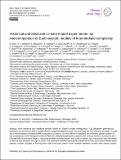| dc.contributor.author | Monier, Erwan | |
| dc.contributor.author | Schlosser, Adam | |
| dc.contributor.author | Sokolov, Andrei P. | |
| dc.date.accessioned | 2013-10-04T14:42:34Z | |
| dc.date.available | 2013-10-04T14:42:34Z | |
| dc.date.issued | 2013-05 | |
| dc.date.submitted | 2013-03 | |
| dc.identifier.issn | 1814-9332 | |
| dc.identifier.uri | http://hdl.handle.net/1721.1/81310 | |
| dc.description.abstract | Both historical and idealized climate model experiments are performed with a variety of Earth system models of intermediate complexity (EMICs) as part of a community contribution to the Intergovernmental Panel on Climate Change Fifth Assessment Report. Historical simulations start at 850 CE and continue through to 2005. The standard simulations include changes in forcing from solar luminosity, Earth's orbital configuration, CO[subscript 2], additional greenhouse gases, land use, and sulphate and volcanic aerosols. In spite of very different modelled pre-industrial global surface air temperatures, overall 20th century trends in surface air temperature and carbon uptake are reasonably well simulated when compared to observed trends. Land carbon fluxes show much more variation between models than ocean carbon fluxes, and recent land fluxes appear to be slightly underestimated. It is possible that recent modelled climate trends or climate–carbon feedbacks are overestimated resulting in too much land carbon loss or that carbon uptake due to CO[subscript 2] and/or nitrogen fertilization is underestimated. Several one thousand year long, idealized, 2 × and 4 × CO[subscript 2] experiments are used to quantify standard model characteristics, including transient and equilibrium climate sensitivities, and climate–carbon feedbacks. The values from EMICs generally fall within the range given by general circulation models. Seven additional historical simulations, each including a single specified forcing, are used to assess the contributions of different climate forcings to the overall climate and carbon cycle response. The response of surface air temperature is the linear sum of the individual forcings, while the carbon cycle response shows a non-linear interaction between land-use change and CO[subscript 2] forcings for some models. Finally, the preindustrial portions of the last millennium simulations are used to assess historical model carbon-climate feedbacks. Given the specified forcing, there is a tendency for the EMICs to underestimate the drop in surface air temperature and CO[subscript 2] between the Medieval Climate Anomaly and the Little Ice Age estimated from palaeoclimate reconstructions. This in turn could be a result of unforced variability within the climate system, uncertainty in the reconstructions of temperature and CO[subscript 2], errors in the reconstructions of forcing used to drive the models, or the incomplete representation of certain processes within the models. Given the forcing datasets used in this study, the models calculate significant land-use emissions over the pre-industrial period. This implies that land-use emissions might need to be taken into account, when making estimates of climate–carbon feedbacks from palaeoclimate reconstructions. | en_US |
| dc.language.iso | en_US | |
| dc.publisher | Copernicus GmbH | en_US |
| dc.relation.isversionof | http://dx.doi.org/10.5194/cp-9-1111-2013 | en_US |
| dc.rights.uri | http://creativecommons.org/licenses/by/3.0/ | en_US |
| dc.source | Copernicus GmbH | en_US |
| dc.title | Historical and idealized climate model experiments: an intercomparison of Earth system models of intermediate complexity | en_US |
| dc.type | Article | en_US |
| dc.identifier.citation | Eby, M., A. J. Weaver, K. Alexander, K. Zickfeld, A. Abe-Ouchi, A. A. Cimatoribus, E. Crespin, et al. “Historical and idealized climate model experiments: an intercomparison of Earth system models of intermediate complexity.” Climate of the Past 9, no. 3 (May 16, 2013): 1111-1140. | en_US |
| dc.contributor.department | Massachusetts Institute of Technology. Center for Global Change Science | en_US |
| dc.contributor.mitauthor | Monier, Erwan | en_US |
| dc.contributor.mitauthor | Schlosser, Adam | en_US |
| dc.contributor.mitauthor | Sokolov, Andrei P. | en_US |
| dc.relation.journal | Climate of the Past | en_US |
| dc.eprint.version | Final published version | en_US |
| dc.type.uri | http://purl.org/eprint/type/JournalArticle | en_US |
| eprint.status | http://purl.org/eprint/status/PeerReviewed | en_US |
| dspace.orderedauthors | Eby, M.; Weaver, A. J.; Alexander, K.; Zickfeld, K.; Abe-Ouchi, A.; Cimatoribus, A. A.; Crespin, E.; Drijfhout, S. S.; Edwards, N. R.; Eliseev, A. V.; Feulner, G.; Fichefet, T.; Forest, C. E.; Goosse, H.; Holden, P. B.; Joos, F.; Kawamiya, M.; Kicklighter, D.; Kienert, H.; Matsumoto, K.; Mokhov, I. I.; Monier, E.; Olsen, S. M.; Pedersen, J. O. P.; Perrette, M.; Philippon-Berthier, G.; Ridgwell, A.; Schlosser, A.; Schneider von Deimling, T.; Shaffer, G.; Smith, R. S.; Spahni, R.; Sokolov, A. P.; Steinacher, M.; Tachiiri, K.; Tokos, K.; Yoshimori, M.; Zeng, N.; Zhao, F. | en_US |
| dc.identifier.orcid | https://orcid.org/0000-0001-5533-6570 | |
| mit.license | PUBLISHER_CC | en_US |
| mit.metadata.status | Complete | |
